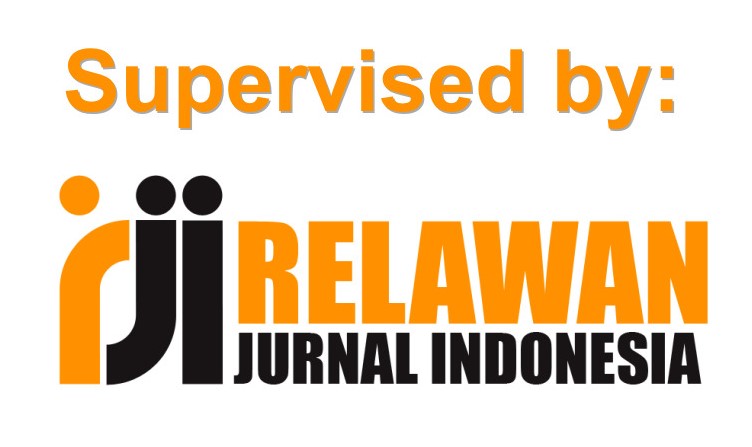Pengukuran Kinerja Optimasi Algoritma Bat Pada Algoritma Naive Bayes, KNN Dan Decision Tree Untuk Sentimen Analisis Di Lini Masa Twitter
Abstract
Keywords
Full Text:
PDFReferences
P. Yudha, “APJII: Jumlah Pengguna Internet di Indonesia Tembus 171 Juta Jiwa,” Kompas.com, 2019.
https://tekno.kompas.com/read/2019/05/16/03260037/apjii-jumlah-pengguna-internet-di-indonesia-tembus-171-juta-jiwa
We Are Social and Hootsuite Survei, “Riset Ungkap Pola Pemakaian Medsos Orang Indonesia,” Kompas.Com, 2018. https://tekno.kompas.com/read/2018/03/01/10340027/riset-ungkap-pola-pemakaian-medsos-orang-indonesia
H. David, Teori Komunikasi, Media, Teknologi, Dan Masyarakat., vol. III, no. 3. Bogor: Ghalia Indonesia, 2014.
Iskandar, “Pilkada Serentak di Indonesia Hasilkan 370.000 Tweets, 13 Desember 2015,” 2015. https://www.liputan6.com/tekno/read/2388665/pilkada-serentak-di-indonesia-hasilkan-370000-tweets
Charlie M. Sianipar, “Jumlah Pengguna Twitter Indonesia Naik Pesat,” Tagar.Id, 2019. https://www.tagar.id/jumlah-pengguna-twitter-indonesia-naik-pesat
P. P. O. Mahawardana, I. A. P. F. Imawati, and I. W. Dika, “Analisis Sentimen Berdasarkan Opini dari Media Sosial Twitter terhadap ‘Figure Pemimpin’ Menggunakan Python,” J. Manaj. dan Teknol. Inf., vol. 12, no. 2, pp. 50–56, 2022, [Online]. Available: https://ojs.mahadewa.ac.id/index.php/jmti/article/view/2111
A. S. H. Basari, B. Hussin, I. G. P. Ananta, and J. Zeniarja, “Opinion mining of movie review using hybrid method of support vector machine and particle swarm optimization,” in Procedia Engineering, 2013, vol. 53, pp. 453–462. doi: 10.1016/j.proeng.2013.02.059.
R. Mohamed, M. M. Yusof, and N. Wahid, “The effectiveness of Bat algorithm for data handling in various applications,” in Proceedings - 6th IEEE International Conference on Control System, Computing and Engineering, ICCSCE 2016, 2017, pp. 151–156. doi: 10.1109/ICCSCE.2016.7893562.
H. Muhamad, C. A. Prasojo, N. A. Sugianto, L. Surtiningsih, and I. Cholissodin, “Optimasi Naïve Bayes Classifier Dengan Menggunakan Particle Swarm Optimization Pada Data Iris,” J. Teknol. Inf. dan Ilmu Komput., vol. 4, no. 3, p. 180, 2017, doi: 10.25126/jtiik.201743251.
A. Kumar and A. Jaiswal, “Empirical study of twitter and tumblr for sentiment analysis using soft computing techniques,” in Lecture Notes in Engineering and Computer Science, 2017, vol. 1, pp. 472–476.
H. Sumarmo, “Komparasi Algoritma Klasifikasi Machine Learning,” BINA Insa. ICT J., vol. VOL 4, no. ISSN : 2527-9777, pp. 189–196, 2017.
S. V. and M. M., “Review: Sentiment Analysis using SVM Classification Approach,” Int. J. Comput. Appl., vol. 181, no. 37, pp. 1–8, 2019, doi: 10.5120/ijca2019917993.
J. C. Zavala-Díaz, M. A. Cruz-Chávez, J. López-Calderón, J. A. Hernández-Aguilar, and M. E. Luna-Ortíz, “A multi-branch-and-bound binary parallel algorithm to solve the knapsack problem 0-1 in a multicore cluster,” 2019. doi: 10.3390/app9245368.
K. A. Chandra, I. M. Widiartha, and A. Muliantara, “Analisis & implementasi algoritma kelelawar sebagai fitur selektor dalam klasifikasi dermatology,” J. Ilmu Komput. Univ. Udayana, vol. IX, no. 2, pp. 15–26, 2016.
H. Khurana and S. K. Sahu, “Bat inspired sentiment analysis of Twitter data,” 2018. doi: 10.1007/978-981-10-6875-1_63.
M. Bilal, H. Israr, M. Shahid, and A. Khan, “Sentiment
classification of Roman-Urdu opinions using Naïve Bayesian, Decision Tree and KNN classification techniques,” J. King Saud Univ. - Comput. Inf. Sci., vol. 28, no. 3, pp. 330–344, 2016, doi: 10.1016/j.jksuci.2015.11.003.
M. A. Hearst, “Text data mining: Issues, techniques, and the relationship to information access,” in Presentation notes for UW/MS workshop on data mining, 1997.
R. Feldman and I. Dagan, “Knowledge Discovery in Textual Databases (KDT),” in International Conference on Knowledge Discovery and Data Mining (KDD), 1995, pp. 112–117. [Online]. Available: http://www.aaai.org/Papers/KDD/1995/KDD95-012.pdf
J. Feldman, R & Sanger, The text mining handbook: advanced approaches in analyzing unstructured data, vol. 44, no. 10. New York: Cambridge Univ. Press, 2007. doi: 10.5860/choice.44-5684.
C. Triawati, M. A. Bijaksana, N. Indrawati, and W. A. Saputro, “Pemodelan Berbasis Konsep Untuk Kategorisasi Artikel Berita,” in Seminar Nasional Aplikasi Teknologi Informasi (SNATI), 2009, vol. 2009, no. Snati, pp. 48–53.
S. Roaf, Introduction to second edition. MIT Press, 2014. doi: 10.5325/j.ctv1c9hns8.7.
KBBI Kemendikbud, “KBBI Daring,” Badan Pengembangan dan Pembinaan Bahasa, Kementerian Pendidikan dan Kebudayaan Republik Indonesia, 2021. https://kbbi.kemdikbud.go.id/entri/optimas (accessed Jun. 12, 2020).
A. Hasad, “Algoritma optimasi dan aplikasinya,” Bogor, 2011.
K. Dave, S. Lawrence, and D. M. Pennock, “Mining the peanut gallery: Opinion extraction and semantic classification of product reviews,” Princeton,NJ; Pasadena, CA, 2003. doi: 10.1145/775152.775226.
D. T. Larose, “Naïve Bayes Estimation and Bayesian Networks,” in Data Mining Methods and Models, Hoboken, NJ, USA: John Wiley & Sons, Inc., 2006, pp. 204–239. doi: 10.1002/0471756482.ch5.
M. Kubek, “Natural Language Processing and Text Mining,” in Studies in Big Data, vol. 62, London, England: Springer Verlag, 2020, pp. 35–52. doi: 10.1007/978-3-030-23136-1_4.
J. Arguello, “Naïve Bayes Text Classification,” The University of North Carolina, 2013. https://ils.unc.edu/courses/2013_fall/inls613_001/lectures/04NaiveBayes Classification.pdf (accessed Apr. 12, 2020).
K. Jain and S. Kaushal, “A Comparative Study of Machine Learning and Deep Learning Techniques for Sentiment Analysis,” in 2018 7th International Conference on Reliability, Infocom Technologies and Optimization: Trends and Future Directions, ICRITO 2018, 2018, pp. 483–487. doi: 10.1109/ICRITO.2018.8748793.
Jyoti and S. Rao, “A survey on sentiment analysis and opinion mining,” in ACM International Conference Proceeding Series, 2016, vol. 12-13-NaN-2016, pp. 7–11. doi: 10.1145/2979779.2979832.
A. P. Jain and V. D. Katkar, “Sentiments analysis of Twitter data using data mining,” in Proceedings - IEEE International Conference on Information Processing, ICIP 2015, 2016, pp. 807–810. doi: 10.1109/INFOP.2015.7489492.
M. Kumaresan, “Sentiment Analysis using Vader,” DELHI TECHNOLOGICAL UNIVERSITY, 2016.
X. S. Yang, A new metaheuristic Bat-inspired Algorithm, Nature Ins., vol. 284. Cambridge, UK: Springer Verlag, 2010. doi: 10.1007/978-3-642-12538-6_6.
DOI: http://dx.doi.org/10.30646/tikomsin.v11i1.731
Refbacks
- There are currently no refbacks.
Editorial Office :
TIKomSiN : Jurnal Teknologi Informasi dan Komunikasi Sinar Nusantara
Published by STMIK Sinar Nusantara Surakarta
Address KH Samanhudi 84 - 86 Street, Laweyan Surakarta, Central Java, Indonesia
Postal Code: 57142, Phone & Fax: +62 271 716 500
Website: https://p3m.sinus.ac.id/jurnal/index.php/TIKomSiN
Email: tikomsin @ sinus.ac.id

This work is licensed under a Creative Commons Attribution-NonCommercial-ShareAlike 4.0 International License.










